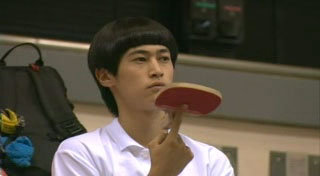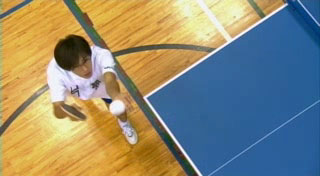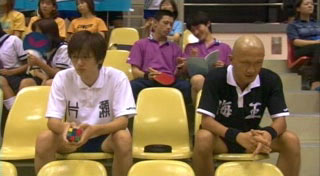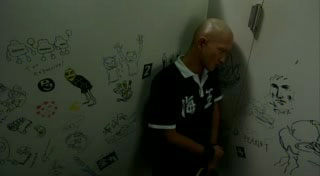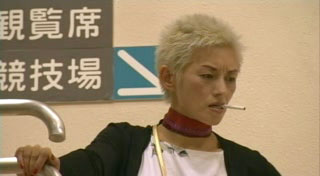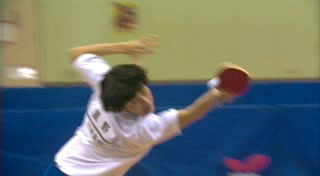 Logo handmade by Bannister
Column by Scott Green
Logo handmade by Bannister
Column by Scott Green
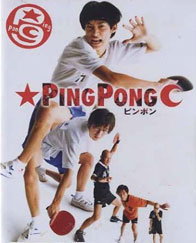
Live Action Spotlight: Ping Pong Released by VIZ Pictures
Given manga artist Taiyo Matsumoto's free flowing twists of view and character shape, it is one thing to see his work adapted into anime, as in Tekkon Kinkreet, but its another to see it made into live action, as in Ping Pong (and for the record, Blue Spring). Fumihiko Sori, best known for his Titanic digital character animation, took up the challenge, and was rewarded with a film that was nominated for eight Japanese Academy Awards, including 'Best Director', winning one for 'Newcomer of the Year' (Shido Nakamura in the role of Dragon). Sori's digital effects complement the story rather than grand stand. The results are a movie that is not just a compelling sports classic in the anime and manga sense, developing characters within the context of the game. Without being be as flashy as Sin City or 300, its one of the best comic to cinema transitions ever filmed. Peco and Smile first met when Peco charged into the circle of bullies tormenting Smile. Soon after, Peco introduced the his ironically nicknamed friend to his passion: ping pong. Years later, both are nominal members of their school's sad-sack ping pong team, where, in theory, they would be training for the intermural tournament. Neither is willing to conform to the model of a scholastic competitor. Peco is still slumming in the local ping pong hall that introduced him to the sport. There he challenges college wannabes for honor and pocket cash. The team coach believes that Smile has the gifts to be an unbeatable player. However, anyone who studies his game can see the obvious. He'd rather let an opponent win than deal with the confrontation, and rather avoid the competition all together.Ping Pong does follow a formulaic structure of defeat, training in earnest and triumph, but that sort of achievement is far from the most compelling feature of the story. The decisions, efforts and personal attributes that go into being a winner turn out to be far more interesting than the actual victory. Perhaps the nature of ping pong as a head-on individual sport helps in this regard. Rather than alliance to a team, there is the intrigue of how the two competitors and what each represents will match up. The film further enhances this athletic debate in the sense that you don't necessarily care if either Peco or Smile wins. To the audience, they are more a subject of fascination than they are heros. The former is arrogant, disinclined to work and by most measures aggravating (perpetually munching on junk food and exhibiting loud, nonsense behavior, such as listening to Born in the USA on his headphones and periodically singing out the single word 'Born'). The later is aloof, uncomfortable about reciprocating attention, and given to obsessing about rubric's cubes and the spin of a tennis ball. Neither essentially "deserves to win." By the values of a more conventional sports movie, the ungifted "hack" players who practice until they bleed or the ones who have uprooted themselves and sacrificed should come out on top. That one does not necessarily see oneself in the protagonist allows attention to rest, not just on the results, but the reactions to the results, what these reactions say about the characters and what they stand for. Rather look out for the objective, the course of the movie is spent studying the people on screen. The game becomes an experiment for testing an introvert and an extravert, and specifically this introvert and this extrovert. Sports can always be taken too seriously, but here, it is a test that is revealing enough to warrant some seriousness. Because competition is such a powerful stimulus, the changes in these resistant characters becomes credible. As the matches play out, the movie works off a compellingly complex value system, that incorporates hard work and dedication, but also, friendship, loyalty and the joy of the game.

Live Action Spotlight: Cutie Honey Released by Bandai Entertainment
Hideaki Anno might have created what is debatably one of the heavier works of televised anime with Neon Genesis Evangelion, but when he turned his hands to adapting Go Nagai's influential manga, the results were a work of sherbet entertainment. In fact, this Power Rangers for the older, irony friendly crowd movie might serve as one of the chief exhibits in the argument that while Anno might have angrily flipped off fans with his End of Evangelion movie, he certainly seems to have gotten the last laugh from that ordeal. You wouldn't expect such a party movie to come from creator who previous works are so closely identified with isolation, particularly self-imposed isolation. Cutie Honey is perfectly adapted for its niche: something to throw on for a social gathering, to laugh at with other viewers or to fit in between heavier subjects in a movie marathon. Many CGI age live action adaptations of anime/manga have taken themselves too seriously and alienated audiences as a result. To almost a calculated degree, Cutie Honey goes the opposite route. It lights off smoke and sparks explosions in classic tokusatsu rock quarries fight scene, it airbrushes out physics for limb-stretching, mid-air dodging live action meets Road Runner antics. One of the genre innovations that Go Nagai is frequently credited with is the transforming magical girl: some ritual where the world briefly turns rose colored and the unassuming school girl turns into a super-heroin garbed in frilly regalia. Sailor Moon is the best recognized example of these Cutie Honey descendants. Besides the infectious, piping theme song used for the anime adaptation, what's most member-able about this character is specifically her transformation sequence. She raises her arm, announces "Honey Flash!" and touches the heart on a metal band around her neck. After the gesture, her clothes peel off, and she either transforms into her battle leotard or the uniform of some endeavor (police woman, motorcycle racer, nurse or some type of attendant). Transformation scenes and the potential for nudity are the tenants of the character. A large portion of making of featurette concerns Anno demonstrating how Eriko Sato should perform the Honey Flash gesture in various scenarios. Beyond the transformation, character details are perfunctory. She is a bit of an Astro Boy character in that she is a robot created in response to the death of a scientist's son. Her Panther Claw enemies are the typical sort of masked terrorists. While their demonic leader Sister Jill and her followers look memorably odd, their personalities and agendas do not take them far beyond the simple villain's post.


Model/actress Eriko Sato is magnetic in the title role. She has the perfect face for mugging for the camera. The movie opens with Honey stepping out of a bath and lounging around in her undergarments. Realizing that she doesn't have the energy to transform herself a set of clothes, she tapes a roll of plastic bags around her body in order to run to the store for rice balls. That sort of gag, in which the innocent character is supernaturally comfortable with her surroundings, makes for a lot of the movie's and the character's charm. Besides a very well formed, trim, body, what's immediately noticeable is Sato's endeavoring round cheeks. The movie allows her to set an expression long enough for the camera to really drink in the look. With the camera close in on her face, she becomes the iconic, unreal character. The goofiness of the looks and situation give her the exaggerated flare of a pop comic book. The movie teams Honey with mod "investigative reporter" Seiji Hayami, as colorful as Honey, but in a tacky-cool vein, and for contrast, the icy police offer Natsuko Aki (Nati), a strict, spectacled overachiever who resides in a room full of empty saki bottles and dead flowers. The movie is zany enough for Nati to axe kick a conference room table, maintaining a deadpan snarl, and disturb the flow the movie. Fortunately, the costumes and sets are such that this volume of performance fits into the depicted world. They seem like characters rather than over-acting performers. the daring approach makes the movie a fun, mixed company experience.


The movie isn't full of action, it is bookended by two battles that do show off idea of live action Looney Tunes fighting. It is a satisfying illusion that is on display. In the dance between Honey's wuxia sword work against almost dancing black suited foes, the classic sci-fi anime missile maneuvering, and the apocalyptic boss battles, it's familiar patterns staged as a new spectacle. Old school fans and those just looking for something fun will get a jolt out of watching Honey trying to outrun a tornado, or deflecting bullets. If you squint hard, you can spot a few sharp corners of Nagai's bleak cosmology and Anno's ambivalence towards the human condition. These elements are not explored with any create depth or subtly, but the dialog does throw out some implications one could run with. When Sister Jill points out that Honey is both newly reborn and immortal, given hundreds of years of life, her happy go-lucky attitude might bleed away, an Evangelion fan would have to think "wow, disaffected Honey could really make for an Anno movie." Almost every adaption of a Go Nagai manga applies a degree of restraint not found in the original. Cutie Honey wasn't Violence Jack, but that doesn't mean it didn't include sick things happening to nude people. A given chapter of Cutie Honey starts with the heroin naked, running through a jungle as she is pursued by motorcycle riding animal women who are either bare-breasted or wearing metal bikinis. Honey transforms into a knight, but the climax involves a giant panther with a human face on its neck ripping off Honey's armor. In contrast, the movie is clean about its joking sexuality. Even Honey's outrageous custom is really just titter worthy. It has cleavage, plenty of skin, a mesh band around one of the thighs, and nipple buttons on its breast cones. This could be entirely too evocative of a stripper-motif, but its so candy colored that it seems like innocent bad taste kitsch. This sort of head-fake towards the daring approach makes the movie a fun, mixed company experience.



Other aspects of Go Nagai's eccentricities do make it into the movie, especially the fascination with gender confusion. With radically androgynous villains, the movie encourages its audience to question the sex of the actors in various roles. On one hand, the movie is presenting these villains in children's life action adventure peacock-flamboyant costumes, on the other, the male villains look feminine, the female villains look masculine. Even Honey gets into the act, changing into a businessman, complete with mustache. In most cases it is a sort of "you don't see me" disparity between what someone looks like and what they presume to be. Watching a movie attempt to recreate this in live action is least as compelling as the missile dodging. Note, contrary to what the packing might say, the Bandai Entertainment DVD release of the film does have a Japanese audio track in addition to the English dub. A benefit to anime fans considering Mayumi Shintani, aka FLCL's Haruko Haruhara plays one of the villains.

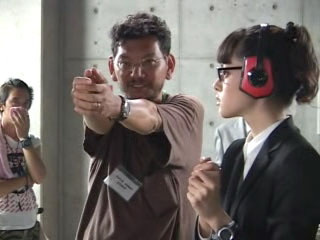
Tekkon Kinkreet Release Plans
Anime News Service notes that Sony lists that Tekkon Kinkreet will be released on DVD September 25th.
Naruto News
VIZ Media has announced that Naruto™ feature film — Naruto The Movie: Ninja Clash In The Land Of Snow will screen on 160 select theaters nationwide for one night June 6, 2007 f. A complete list of cities is located on the VIZ Media’s web site at www.VIZ.com. In coming days, VIZ Media will also send registered subscribers of its SHONEN JUMP magazine a special invitation to purchase advance tickets which will include the link to purchase tickets beginning on April 27. Tickets to the general public will go on sale on April 30 through the Fathom website at www.FathomEvents.com. Speaking of Naruto movies, the fourth Naruto movie, the first from the Naruto Shippuden phase of the franchise, is planned to hit Japanese theaters on August 4th. VIZ also announced that they will be releasing three volume of Naruto a month in late 2007. The new publishing schedule will carry the series up to Volume 27, after which there is a significant break in the story arc: Two and a half years pass, and we find Naruto taller, older, and wiser. To support NARUTO NATION, VIZ Media’s SHONEN JUMP magazine will continue to serialize the NARUTO series, will provide in-depth background information for fans about the developments in the accelerated manga, and will begin to feature the new adventures of the older Naruto beginning in the January 2008 issue (estimated in stores December 4, 2007). The specific manga release schedule is as follows: September 2007: NARUTO Vols. 16-18 October 2007: NARUTO Vols. 19-21 November 2007: NARUTO Vols. 22-24 December 2007: NARUTO Vols. 25-27 Complementing the increased manga momentum, VIZ Media will expand the catalog of other related NARUTO offerings with a variety of releases this fall and winter. September will see the release of the NARUTO ANIME PROFILES: Hiden Shippu Emaki, and the launch of the full-color Ani-Manga series that will depict the storyline of NARUTO THE MOVIE: NINJA CLASH IN THE LAND OF SNOW, which is also set for a special theatrical engagement this summer. In October VIZ Media will publish a gorgeous UZUMAKI: ART OF NARUTO edition that will be a must-have for any collector and also NARUTO MISSION: PROTECT THE WATERFALL VILLAGE!, the latest addition to the collection of NARUTO novels under the VIZ Fiction imprint. A fourth edition of the NARUTO COLLECTOR magazine will be released this fall, focusing on the manga and on the release of the first NARUTO game for the Xbox 360.
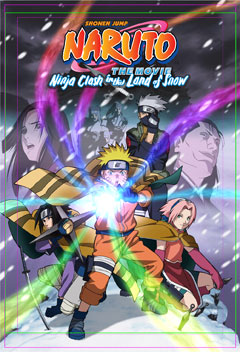
Convention News
Anime Expo announced that director Tetsuro Araki and character designer Masaru Kitao will attend the convention as Official Guests of Honor. In addition, Anime Expo has also obtained the rights to screen the blockbuster films, starring Tatsuya Fujiwara, from Japan DEATH NOTE and DEATH NOTE: THE LAST NAME (140 minutes) on 35 mm print at the highly anticipated 2007 convention June 29-July 2 at the Long Beach Convention Center. Tetsuro Araki is the director of the "Desu nôto" (2006 also known as DEATH NOTE) TV Series (produced by Madhouse, Nippon Television, Shueisha and VAP). Masaru Kitao is the sole character designer of the "Desu nôto" (2006 also known as DEATH NOTE) TV Series characters (produced by Madhouse, Nippon Television and VAP). The New York Anime Festival (NYAF) that anime industry veteran Peter Tatara has joined the show as its Programming Manager. Tatara will be responsible for crafting the first NYAF's look, feel, programming, and marketing. A former Marketing Manager at anime distributor Central Park Media and manga publisher Be Beautiful Manga, Tatara comes to NYAF with a background in both the anime industry and anime community as a whole. He recently served as Anime Programming Manager at New York Comic Con 2007 and will now be channeling his efforts into the inaugural NYAF. The New York Anime Festival takes place December 7-9, 2007 at the Jacob K. Javits Center in Midtown Manhattan and is organized by Reed Exhibitions, the creators of New York Comic Con. The New York Anime Festival will showcase the best of anime pop culture, including the latest anime, manga, Japanese cinema, music, and games, and anime-influenced comics, animation, and films from around the world. The festival will feature exclusive and extensive screenings, a gala cosplay masquerade, sessions with the some of the biggest names in anime from Japan, Asia, and America, and explore the Japanese cultural experience with displays of both traditional and cutting-edge Japanese apparel, cuisine, and life.
Manga/OEL Nominated for 2007,Will Eisner Comic Industry Awards
Best Continuing Series Naoki Urasawa’s Monster, by Naoki Urasawa (Viz) Best New Series East Coast Rising, by Becky Cloonan (Tokyopop) Best Anthology Japan as Viewed by 17 Creators, edited by Frédéric Boilet (Fanfare/Ponent Mon) Best Reality-Based Work Project X Challengers: Cup Noodle, by Tadashi Katoh (Digital Manga) Best Archival Collection/Project—Comic Books Abandon the Old In Tokyo, by Yoshihiro Tatsumi (Drawn & Quarterly) Ode to Kirihito, by Osamu Tezuka (Vertical) Best U.S. Edition of International Material—Japan After School Nightmare, by Setona Mizushiro (Go! Comi) Antique Bakery, by Fumi Yoshinaga (Digital Manga) Naoki Urasawa’s Monster, by Naoki Urusawa (Viz) Old Boy, by Garon Tsuchiya and Nobuaki Minegishi (Dark Horse Manga) Walking Man, by Jiro Taniguchi (Fanfare/Ponent Mon) Special Recognition Ross Campbell, Abandoned (Tokyopop); Wet Moon 2 (Oni) Svetlana Chmakova, Dramacon (Tokyopop)
Upcoming Geneon Releases
7/17 The Law of Ueki: The Key to Victory (Volume 8) Karin: Vampire Hunter (Volume 2) Minisuka Police Volume 1 ($19.98) The Mini-skirt Police: To serve, protect, tease and titillate! Get an luscious eyeful of the sexiest female "cops" to ever flash across TV screens with the Mini-suka Police! Only these hot cuties in tight shirts and even tighter skirts are able to lay down their own unique brand of "law" that's equal parts wickedly mischievous, naughty and downright hilarious! Reality TV will never be the same again as the leggy beauties of the Mini-skirt Police engage in skit-after-outrageous skits, wacky contests and revealing scenarios in this hilarious game & stunt show that will have viewers pining for these gals to arrest you! Featuring secondary English audio track commentary by New York comedian (D.C. Benny) done in the style of ?Mystery Science Theatre 7/24 Ergo Proxy Terra Incognita (volume 5) Black Lagoon 2 (a limited edition version will be packaged with a dog tag) 8/21/07 Fate/Stay Night: Medea (volume 5) The live action Princess Raccoon is now scheduled to be released on 7/10 Geneon Will also be distributing the following Bandai Visual releases 7/10 Galaxy Angel Rune Episode 1: Launch! Angels Scramble-Rune ($19.99) Hi! It’s nice to meet you, this is Apricot Sakuraba. Please call me Rico! We, the Angel Troupe, are working hard to preserve peace in the galaxy!! Anise-san is especially on the edge because she owes money to people. She’s amazing, and maybe I should be more like her. But when I see carefree, cat-like Nano-chan sunbathing, I lose that thought… Kahlua-san is continuing to explode her lab with her magical experiments, but I’m still looking forward to the day she succeeds. Oh, and she promised that when she turns into Tequila, she will show me a good way to overcome my fear of men…but it might be something that our captain, Lily-san may get seriously upset for being “against the way.” Anyway, please support us either way! The sequel to the popular "moe" comedy series, Galaxy Angel DVD extras include: Concert Clips, Textless opening and ending, and trailers The Wings of Rean volume 2 $39.99
Upcoming Manga In Manga North America
MangaBlog has learned FanFare plans to release Summit of the Gods by Yumemakura Baku and Taniguchi Jiro. Other planned releases include: The Ice Wanderer - Jiro Taniguchi Awabi - Kan Takahama Disappearance Diary Korea As Viewed By 12 Creators The Quest for the Missing Girl - Jiro Taniguchi ICV2 reports Yaoi Press will launch a comic format releases with the bi-monthly Yaoi Candy and the one shot Offered to a Demon starting in October. Publishers Weekly talks Vertical's upcoming shoujo manga line. A 25 page except of Osamu Tezuka's Princess Knight will be included in the July issue of Viz's Shoujo Beat. Speaking of manga, Anime News Network reports that Amulet Books will publishing Hokusai: First Manga Master in June. The book looks at the works of Katsushika Hokusai and how the 19th century artist laid the foundation for modern manga.
Gaogaigar On Hiatus
Anime on DVD and Toon Zone report that after volume 5, scheduled for a June 5th release, Media Blaster will again put their release of cult mecha show Gaogaigar on hiatus to focus on their release on Voltron. The distributor is also deciding whether to continue production of an English language dub for the anime.
New and Upcoming in Japan
From Anime News Network A trailer for Madhouse/Mitsuo Iso's Denno Coil is online here. A second season of geek comedy/drama Genshiken, following the original TV series and OVA packaged with Kujibiki Unbalance, is now scheduled for a fall TV premiere. Shin SOS Dai Tokyo Tankentai (The New SOS Tokyo Metro Explorers) is scheduled on open on May 19th. The movie, directed by Steamboy and Blood: The Last Vampire's technical animation director Shinji Takagi adapts a manga by Akira creator Katsuhiro Otomo. The first episode of GONZO's Romeo × Juliet< is streaming online between April 21 and May 5 here. The first of a five episode Kyo Kara Maoh! OVA is schedule for October 26. Same Hat! looks at Eiji Nonaka's (Cromartie High) new manga Mirai Chounaikai. A new Nissin Freedom commercial with Hikaru Utada's new single "Kiss and Cry" can be seen in 1Mbps or 300kbps bandwidth. New sites include Code-E homepage, with a trailer here Buzzer Beater Zwei
New Digimon on US TV
ToonZone.net reports Digimon Savers has been picked up by Disney to be be shown on the Jetix, Toon Disney block this fall under the title "Digimon Data Squad."

